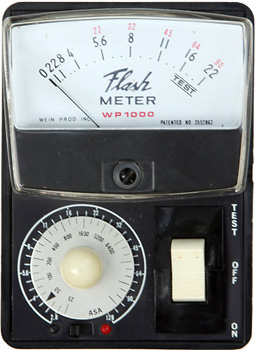
|
  Maker: Wein Model: WP-1000 Circa: 1969 Price (new): $130 (2008) Designer: Stanley Weinberg US Patent: 3,552,862 Battery: 9v Measure type: Flash Modern Photography Review: June 1969 |
|
This is an entry-level flash meter. Normal meters (even the killers on modern DSLRs) only measure continuous light. Flash (aka strobe) is too fast to measure properly; a flash meter looks for that flash and holds the peak. This was quite the little rig when it first came out. Prior to this, flash meters were big studio jobs that needed to be directly synched into the lighting system, and they were luggables. This one you could tuck in the gadget bag, you'd set it next to your subject, pop your flash and get a reading. No sync cords. No fuss. It's only about 4 x 2½ x 2 inches. My Luna Pros are larger! Plus you can use a 9v battery, which can still be easily found. Try that with your high-end meters of that era. Of course the modern electronic meters (like my Calcu-Flash) blow it away. They can measure and record various readings and do all kinds of neat things, but they're expensive. This one is $130 brand new, and a lot cheaper on eBay (I paid $10 for this one and it's pristine), so they're a great entry into flash. And that's another thing. Hand-held meters have been made mostly obsolete by modern camera meters. Modern camera meters offer user-selectable weight patterns and spot measurement. But they don't do flash. They won't measure flash, they don't store the readings. They do everything by measuring ambient light and making predictions on what their on-board or TTL flash units do. That's considerable brain-power, but it's still limited. And if you're using flash units that aren't electronic marvels that communicate with your camera (like a simple strobe using a slave, or even on a simple sync cord)—the camera can't predict what happens—you have to do it. Flash meters are still relevant in the post digital world. It amazes me how cheaply and easily they can be had. |
|
©opyright by James Ollinger. All Rights Reserved.
Company names and models are registered trademarks of their respective owners
and are not affiliated with this website in any way.

s.jpg)